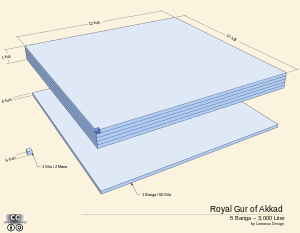Ancient Mesopotamian units of measurement

Ancient Mesopotamian units of measurement originated in the loosely organized city-states of Early Dynastic Sumer. Each city, kingdom and trade guild had its own standards until the formation of the Akkadian Empire when Sargon of Akkad issued a common standard. This standard was improved by Naram-Sin, but fell into disuse after the Akkadian Empire dissolved. The standard of Naram-Sin was readopted in the Ur III period by the Nanše Hymn which reduced a plethora of multiple standards to a few agreed upon common groupings. Successors to Sumerian civilization including the Babylonians, Assyrians, and Persians continued to use these groupings. Akkado-Sumerian metrology has been reconstructed by applying statistical methods to compare Sumerian architecture, architectural plans, and issued official standards such as Statue B of Gudea and the bronze cubit of Nippur.
Archaic system[]

The systems that would later become the classical standard for Mesopotamia were developed in parallel with writing during Uruk Period Sumer (c 4000 BCE). Studies of protocuneiform indicate twelve separate counting systems used in Uruk.
- Sexagesimal System S used to count slaves, animals, fish, wooden objects, stone objects, containers.
- Sexagesimal System S' used to count dead animals, certain types of beer
- Bi-Sexagesimal System B used to count cereal, bread, fish, milk products
- Bi-Sexagesimal System B* used to count rations
- GAN2 System G used to count field measurement
- ŠE system Š used to count barley by volume
- ŠE system Š' used to count malt by volume
- ŠE system Š" used to count wheat by volume
- ŠE System Š* used to count barley groats
- EN System E used to count weight
- U4 System U used to count calendrics
- DUGb System Db used to count milk by volume
- DUGc System Db used to count beer by volume
In Early Dynastic Sumer (c 2900–2300 BCE) metrology and mathematics were indistinguishable and treated as a single scribal discipline. The idea of an abstract number did not yet exist, thus all quantities were written as metrological symbols and never as numerals followed by a unit symbol. For example there was a symbol for one-sheep and another for one-day but no symbol for one. About 600 of these metrological symbols exist, for this reason archaic Sumerian metrology is complex and not fully understood.[1] In general however, length, volume, and mass are derived from a theoretical standard cube, called 'gur', filled with barley, wheat, water, or oil. However, because of the different specific gravities of these substances combined with dual numerical bases (sexagesimal or decimal), multiple sizes of the gur-cube were used without consensus. The different gur-cubes are related by proportion, based on the water gur-cube, according to four basic coefficients and their cubic roots.[citation needed] These coefficients are given as:
- Komma = 80⁄81 correction when planning rations with a 360-day year
- Leimma = 24⁄25 conversion from decimal to a sexagesimal number system
- Diesis = 15⁄16
- Euboic = 5⁄6
One official government standard of measurement of the archaic system was the Cubit of Nippur (2650 BCE). It is a Euboic Mana + 1 Diesis (432 grams).[citation needed] This standard is the main reference used by archaeologists to reconstruct the system.
Classical system[]

A major improvement came in 2150 BCE during the Akkadian Empire under the reign of Naram-Sin when the competing systems were unified by a single official standard, the royal gur-cube.[2] His reform is considered the first standardized system of measure in Mesopotamia.[2] The royal gur-cube (Cuneiform: LU2.GAL.GUR,